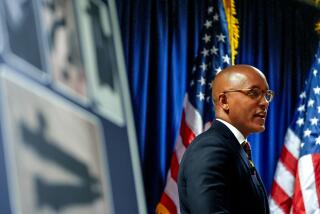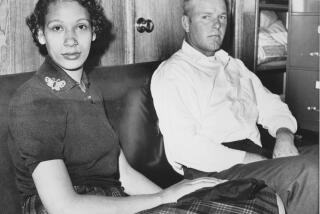PERSPECTIVE ON THE SIMPSON CASE : Race and Sex--the Last Taboo Lives : Once again, America taps into a favorite white stereotype--the black man as hypersexual and dangerous.
The semi-nude picture of O.J. and Nicole Simpson on the cover of People magazine made me shudder. Would this be a chilling reminder to many whites that a black man, albeit a wealthy and famous one, not only was suspected of murder but also had violated Americaâs last taboo against interracial sex? If so, his indictment would be mine, too. This is not paranoia.
Many black men cringed the moment O.J. became a suspect in the murder of his wife. Many of us were reminded of Bigger Thomas, the character in Richard Wrightâs âNative Sonâ who murdered a white woman, reinforcing the ancient white fears of black men as hypersexual and dangerous. To many black men, O.J. may become the new Bigger Thomas.
Although thousands of Asian, Latino and white men, some wealthy and prominent, have been accused of sexual crimes and abuses, four black men have become the symbols of male sexual menace. The Clarence Thomas confirmation hearings touched off the national debate over sexual harassment. Mike Tysonâs conviction touched off the debate over âdate rape.â A 13-year-oldâs accusation against Michael Jackson touched off the debate over child sexual abuse. O.J. Simpsonâs arrest has touched off the debate over domestic violence.
There are two reasons for this symbolism. First is the negative view many Americans have of black men. The dire plight of young black men has much to do with that view. The California Assembly Commission on the Status of African American Males notes that four out of 10 men entering California prisons are black. Only 43% of black males under age 21 live with two parents. Black males with a high school education are twice as likely as white males to be unemployed. The national figures mirror those in California.
Nearly 1,000 black teen-age males a year die from gunfire, according to the National Center for Health Statistics. Young black males are seven times more likely than whites to end up as homicide victims.
The media obsession with ghetto crack, gangs and poverty has convinced many Americans that black males are hopelessly trapped in a grim netherworld of anger and violence.
Even O.J. was not immune. He grew up in a single-parent household in a tough section of San Francisco. He flirted with gangs. Some media reports have suggested that only his incredible athletic talent and luck spared him a prison rap sheet.
But nothing stirs latent hostilities toward black men more than the X factor of interracial sex. Sexual fear is a product of Americaâs long history of racial stereotyping. In early 20th-Century popular literature, black men were routinely depicted as lustful, sex-crazed brutes. Thomas Dixon in his wildly successful 1905 novel, âThe Clansman,â branded the black man âhalf child, half animal, whose passions, once aroused, are as the fury of the tiger.â D.W. Griffith immortalized that image for millions of filmgoers in âBirth of a Nationâ in 1915. Film critics still praise it as a classic.
In âAmerican Dilemma,â Swedish sociologist Gunnar Myrdal called Americaâs perverse preoccupation with black male sexuality âthe main defense for segregation.â Clarence Thomas was mindful of this tragic history when he called Anita Hillâs accusations of sexual misconduct a âhigh-tech lynching.â
It was no accident that the final battle of legal segregation was fought over interracial marriage laws. In 1949, 30 states prohibited marriage between blacks and whites. When the Supreme Court struck down the prohibition in 1967, 17 states made interracial marriage a felony offense. Twelve states still had anti-miscegenation laws on the books well into the 1970s.
While polls show that the majority of white Americans no longer oppose interracial marriages, a substantial number do. A 1991 General Social Survey conducted by the National Opinion Research Center reported that one in five whites believes that interracial marriage should be illegal; marriage between black men and white women is frowned on the most. But even 66% of those who donât oppose interracial marriage say they would oppose a close relative marrying a black man. Forty-five percent in the survey were opposed to Anglos marrying Latinos or Asians.
Many churches arenât beacons of enlightenment on mixed marriages, either. Sociologist Ernest Porterfield in âBlack and White Mixed Marriagesâ discovered that the majority of mixed couples who attended church before marriage discontinued attendance afterward.
South African expatriate Mark Mathabane, whose wife is white, recounts in âLove in Black and Whiteâ bitter encounters with racism in America. Mathabaneâs experience is not exceptional. The sight of a black male and white female together often brings hostile stares, insults, harassment and physical attack. This is why black-white marriages are a rarity. According to the 1990 Census, only 4% of black men have married white women.
While O.J. gained fame as athlete, entertainer and media personality, he carefully avoided racial or political controversy. This earned him mainstream acceptance, hero status and temporary exemption from racial backlash for marrying white. But many black men know this exemption doesnât apply to them. Thatâs why we worry that if O.J. is put on trial, so will we be.
More to Read
Sign up for Essential California
The most important California stories and recommendations in your inbox every morning.
You may occasionally receive promotional content from the Los Angeles Times.










